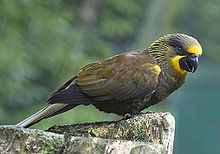Brown lory
| Brown lory | |
|---|---|

| |
| Scientific classification | |
| Domain: | Eukaryota |
| Kingdom: | Animalia |
| Phylum: | Chordata |
| Class: | Aves |
| Order: | Psittaciformes |
| Family: | Psittaculidae |
| Genus: | Chalcopsitta |
| Species: | C. duivenbodei
|
| Binomial name | |
| Chalcopsitta duivenbodei Dubois, 1884
| |
The brown lory (Chalcopsitta duivenbodei), also called Duyvenbode's lory, is a species of parrot in the family Psittaculidae native to northern New Guinea.
Taxonomy[edit]
The brown lory is one of three species in the genus Chalcopsitta. Within the genus, it is basal to the two other species.[2]
The generic name comes from the Greek khalkos, meaning bronze, and the Modern Latin psitta, meaning parrot. The specific epithet commemorates the Dutch merchant Maarten Dirk van Renesse van Duivenbode.[3]
The species is monotypic. Populations from northeastern New Guinea are sometimes treated as a distinct subspecies, C. d. syringanuchalis, on the basis of differences in plumage. Birds from the Sepik River area have also been proposed as a separate subspecies C. d. intermedia, but are almost universally subsumed into the nominate or (where two subspecies are recognised) into syringanuchalis.[4]
Description[edit]
The brown lory has a black beak, yellow-streaked face, white tail and mostly dark brown plumage.
Behaviour and ecology[edit]
Breeding[edit]
Breeding occurs in April. In captivity, clutches were of two eggs, with an incubation period of 24 days and a nestling period of nearly 11 weeks.[5]
Habitat and conservation[edit]
The brown lory is found in northern New Guinea. Its natural habitat is subtropical or tropical moist lowland forests, with elevations up to 150 m (492 ft). It is considered generally uncommon in its range, though it is locally common in certain areas (such as the Puwani River area south of Vanimo).
Status[edit]
The species is listed as least-concern by the IUCN. However, its population is thought to be declining. The overall population is estimated at 50,000 individuals.[6]
References[edit]
- ^ BirdLife International (2018). "Chalcopsitta duivenbodei". IUCN Red List of Threatened Species. 2018: e.T22684491A130098893. doi:10.2305/IUCN.UK.2018-2.RLTS.T22684491A130098893.en. Retrieved 12 November 2021.
- ^ Joseph, L.; Merwin, J.; Smith, B.T. (2020). "Improved systematics of lorikeets reflects their evolutionary history and frames conservation priorities". Emu - Austral Ornithology. 120 (3): 201–215. doi:10.1080/01584197.2020.1779596.
- ^ Jobling, James A. (2010). Helm Dictionary of Scientific Bird Names. Christopher Helm. pp. 98, 141. ISBN 978-1-4081-3326-2.
- ^ "Parrots, cockatoos – IOC World Bird List". Retrieved 2021-07-21.
- ^ Collar, Nigel; Boesman, Peter F. D. (2020-03-04), Billerman, Shawn M.; Keeney, Brooke K.; Rodewald, Paul G.; Schulenberg, Thomas S. (eds.), "Brown Lory (Chalcopsitta duivenbodei)", Birds of the World, Cornell Lab of Ornithology, doi:10.2173/bow.brolor1.01, retrieved 2021-07-21
- ^ International), BirdLife International (BirdLife (2018-08-06). "IUCN Red List of Threatened Species: Chalcopsitta duivenbodei". IUCN Red List of Threatened Species. Retrieved 2021-07-21.
External links[edit]
- World Parrot Trust Parrot Encyclopedia - Species Profile

